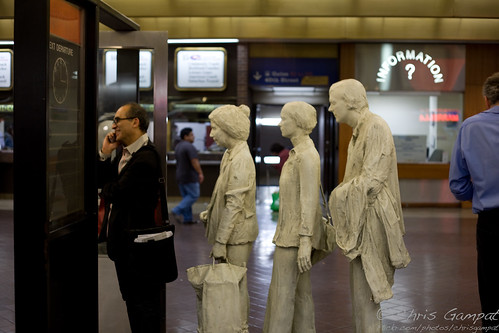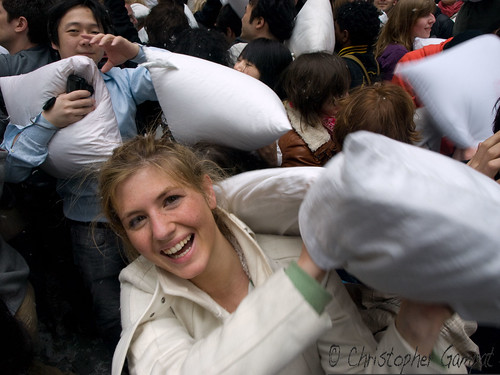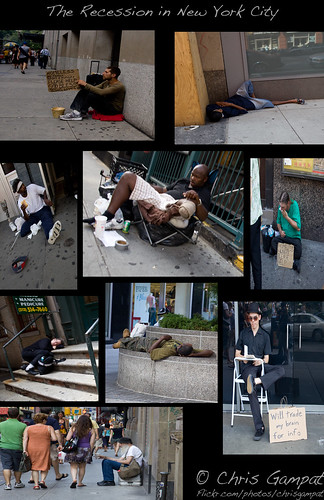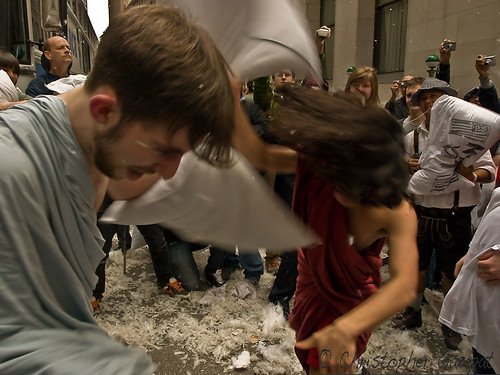Since the arrival of the Leica M9, bloggers have been abound with posts about Leicas, street photography, and why you need a rangefinder right now. Further, Chris Weeks has made a documentary on street photography and the human condition. If you watch it, you’ll see that it’s very pro-rangefinder. A personal critique of mine is that it almost seems like what we call in the industry to be an “advertorial.” To clarify, this is an article or piece of media that is supposed to be presented in a journalistic fashion but can seem more like subliminal marketing. To be fair, Mr. Weeks probably does legitimately love Leicas for street photography. However, as a photographer that has shot with all brands of cameras, I see no reason why a DSLR can’t do the same job. Regular readers of this blog may know that street photography is some that is held dear to me. More on this after the jump.
Author’s Note: This is not an anti-Leica post, when I worked for Magnum Photos many of their photographers used Leicas. I hold them in high regard and respect their history, but this post is about you as a photographer.
As a photographer with nowhere enough money to afford a brand spankin’ new Leica M9, it’s fair to say that just because there isn’t a Leica in my hands doesn’t mean that other photographers or I can’t take pictures just as well as the Leica street photographers and the likes of Henri Cartier-Bresson can. Granted, those images are all very beautiful but street photography can be done without the use of a rangefinder as costly as the Leica M9. Sure, you can go for the older Leicas which are much cheaper but then you still need to invest in the lenses. In that case, you can use what’s being called the poor-man’s Leica – Micro Four Thirds. Additionally, a DSLR can do the same job perfectly fine as long as you come out of your timidness shell.
The important thing to remember in street photography is being discrete, not interacting with your subjects and simply documenting. If someone gives you a bad look, your confidence and smile should be able to disarm any bad feelings towards you. One can surely be discrete with a camera like the 5D Mk II and a 50 mm F1.8 II prime lens. In big cities, people are usually too busy going along with their daily routines to worry about someone that is walking around with a big camera. Chances are that they’ll think you’re simply just a tourist.
Additionally, there are many techniques that you can use to shoot. In the compilation above, some of those photos were taken with a technique I’ve been working on perfecting: shooting from the hip without looking into the viewfinder. It literally is just pointing the lens in the direction of your subject while the camera is at your hip and pressing down on the shutter button. Chances are that you’ll need to autofocus but it can be done. An advantage of this is that you are being discrete, using and learning a new method and you are getting a different perspective that one usually doesn’t see in photos by effectively breaking the rule of thirds.
Since when was street photography more about the camera than the photographer and subjects themselves? To be fair, it is done best with interchangeable lens cameras. Brad Elterman of Buzzfoto shoots with a Canon 20D and 50mm F1.2 L and is much regarded for combining artsy styles and street photography with his paparazzo work. If images like that can come out of an older Canon sensor, why does one need to blow thousands on a Leica? Additionally, many of those cameras are very simple as it is and sharp glass can be obtained rather cheaply. Further, film users can pick up some nice Fuji Velviclor or Kodak Monochrome film, put it in their SLR and start snapping away. For users that already have interchangeable lens cameras, it is fair to say that the money can be better spent on other equipment like lenses.
We as photographers need to keep in mind that our cameras are only as good as the photographers behind the viewfinders.
So, do you need a rangefinder to do street photography? What are your thoughts?






It’s never about the equipment, I believe. Rangefinder, DSLR, P&S…Whatever.
This photo was taken with a simple P&S camera – http://www.ilanbresler.com/2009/08/sunscreen.html
What job did you have at Magnum?
No, but it helps (once you’re used to it).
IIan- That shot is so real and lifelike. Granted I’m a bit disgusted by the image of the lady, but that’s what’s real and on the streets. It’s not always what we see in the movies. Nice capture. But you’re right, I don’t believe that you need one.
Poagao- I used to be a special blogs intern. The blog I worked for was called Insight, it chronicled the days before the election last year. It required working with photographers, editors, editing/resizing photos, doing a bit of promotions research, coming up with ideas at meetings to embrace the web more, etc.
Tom- Please elaborate. I’m interested in the other opinion.
Street photography can in principle be done with any kind of camera, except maybe a pinhole camera: real street photography is about people in their social surroundings, not about streets. For many years I have used a succession of camera types for my street photography (for instance several Nikon models and Leica M’s, Contax G2’s, even compacts), and found the Leica very useful for the following reasons:
– the camera is strong, quiet and inconspicuous, doesn’t look “macho” or “threatening” (some people even called it “oldfashioned”);
– very clear rangefinder, even in bad light; for extra comfort I often use a slide-on rangefinder to match the wideangle;
– very compact and excellent lenses;
The negative point is that it takes some getting used to, and – last but not least – the price. I also have to add that I’m a black and white film photographer (as you probably already guessed).
Isn´t a case of a NEED of a rangefinder,but it´s a matter of praticity – RF cameras are light,silent,rapid,small and don´t intimate the people. The bright viewfinder is a bonus to street shooting,too. Street photography with a DSLR and a big lens (fast one)? don´t made sense to me…
I agree with Tom and Marcello. Rangefinders, in most all instances, have quiet shutters (except Bessa R’s), and because of this and their smaller size they are easy to carry and pull out on the street without intimidating the subject like an SLR can. By setting a pre-focus, you can snap away with hardly anyone noticing. Try that with a bulky SLR or a slow-focus, noisy-motor point-and-shoot. Of course one can do street photograph with an SLR, but it’s the wrong tool IMO.
________
Street photography requires that you know your camera so well, you don’t waste a moment thinking about controls. Shoot and keep shooting you’ll walk miles and have bad bad days. but slowly you’ll develop an instinct for a picture. You may have a favourite photographer, that may help you in the early day’s,but keep plugging away and perhaps you’ll suprise yourself. So…..forget the type of camera for a while and train the eye…….thats when the pictures start to come……………..”the harder I work, the luckier I become” …………….and we all need lady luck on our side !
Your equipments, be it a Leica M9, Canon 5D, Nikon D3s, etc. will be useless and all your photos will be crap if you don’t combine your imagination with it. All your cash spent on those expensive snappers, drained like shit on a toilet bowl.
@mark: I truly hope you meant to say “…drained like **** IN a toilet bowl”. Nonetheless, it’s a smelly comment for sure.
I suppose, if one can buy all that expensive gear, then could also afford the servant to come in and clean the toilet bowl after they…
As for the rest…a bit obvious, don’t you think?!
There seems to be a lot of fuss about this lately – to me its simple, do you ‘need’ one? of course not, do they help, of course, anyone should be able to see that.
I am seriously thinking of purchasing a Leica M7 and the 50 2.0 and the 28 2.0. I yearn to shoot film once again. brad
You do not need a rangefinder, but for composing and reacting rangefinders are better, simply for the reason that your view on both eyes is the same and you can see people walking in and out of your shot much better that way. Doing that on a (D)SLR gives me a very strong headache. They are also most often not that noticeable.
Shut up and shoot.
Check out the Ricoh grd3. 28mm lens, an external viewfinder, no shutter lag when you zone focus.
I disagree with most of this. Sure, you don’t need a Leica. That doesn’t mean that anything else will do either; SLR’s are big and noisy and cheap digital compacts have terrible shutter lag and fall asleep at random.
A Micro-4/3 with any standard (17-35mm) prime lens; will be fine. However if you don’t have one of those…
The best tool for a beginner at Street Photography, is an all mechanical compact like the Olympus Trip or the Rollei 35. It’ll cost you $5 in a yard sale or $20 from a camera store. Use a roll of XP2 and get it developed at a minilab; or a roll of Tri-X or HP5 if you have access to a darkroom; e.g. at a college.
This will teach you composition of black and white photography with a single fixed lens; and how to shoot with scale focusing. Street Photographer 101. By the time you’re good enough to consider playing with color film or maybe thinking about getting that film Leica, Fuji X or Pen digital; you’ll also know if this is something you want to do seriously. Bonus points, you’ll only have spent $100!